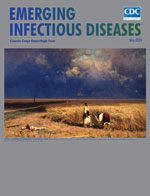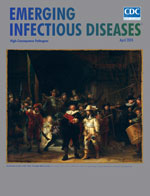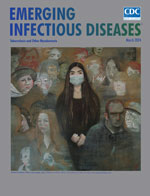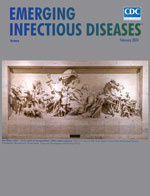Medscape CME Activity
Medscape, LLC is pleased to provide online continuing medical education (CME) for selected journal articles, allowing clinicians the opportunity to earn CME credit. In support of improving patient care, these activities have been planned and implemented by Medscape, LLC and Emerging Infectious Diseases. Medscape, LLC is jointly accredited by the Accreditation Council for Continuing Medical Education (ACCME), the Accreditation Council for Pharmacy Education (ACPE), and the American Nurses Credentialing Center (ANCC), to provide continuing education for the healthcare team.
CME credit is available for one year after publication.
Volume 30—2024
Volume 30, Number 5—May 2024

Crimean-Congo hemorrhagic fever (CCHF) is a tickborne infection that can range from asymptomatic to fatal and has been described in >30 countries. Early identification and isolation of patients with suspected or confirmed CCHF and the use of appropriate prevention and control measures are essential for preventing human-to-human transmission. Here, we provide an overview of the epidemiology, clinical features, and prevention and control of CCHF. CCHF poses a continued public health threat given its wide geographic distribution, potential to spread to new regions, propensity for genetic variability, and potential for severe and fatal illness, in addition to the limited medical countermeasures for prophylaxis and treatment. A high index of suspicion, comprehensive travel and epidemiologic history, and clinical evaluation are essential for prompt diagnosis. Infection control measures can be effective in reducing the risk for transmission but require correct and consistent application.
| EID | Frank MG, Weaver G, Raabe V. Crimean-Congo Hemorrhagic Fever Virus for Clinicians—Epidemiology, Clinical Manifestations, and Prevention. Emerg Infect Dis. 2024;30(5):854-863. https://doi.org/10.3201/eid3005.231647 |
|---|---|
| AMA | Frank MG, Weaver G, Raabe V. Crimean-Congo Hemorrhagic Fever Virus for Clinicians—Epidemiology, Clinical Manifestations, and Prevention. Emerging Infectious Diseases. 2024;30(5):854-863. doi:10.3201/eid3005.231647. |
| APA | Frank, M. G., Weaver, G., & Raabe, V. (2024). Crimean-Congo Hemorrhagic Fever Virus for Clinicians—Epidemiology, Clinical Manifestations, and Prevention. Emerging Infectious Diseases, 30(5), 854-863. https://doi.org/10.3201/eid3005.231647. |
Crimean-Congo hemorrhagic fever virus (CCHFV) is the most geographically widespread tickborne viral infection worldwide and has a fatality rate of up to 62%. Despite its widespread range and high fatality rate, no vaccines or treatments are currently approved by regulatory agencies in the United States or Europe. Supportive treatment remains the standard of care, but the use of antiviral medications developed for other viral infections have been considered. We reviewed published literature to summarize the main aspects of CCHFV infection in humans. We provide an overview of diagnostic testing and management and medical countermeasures, including investigational vaccines and limited therapeutics. CCHFV continues to pose a public health threat because of its wide geographic distribution, potential to spread to new regions, propensity for genetic variability, potential for severe and fatal illness, and limited medical countermeasures for prophylaxis and treatment. Clinicians should become familiar with available diagnostic and management tools for CCHFV infections in humans.
| EID | Frank MG, Weaver G, Raabe V. Crimean-Congo Hemorrhagic Fever Virus for Clinicians—Diagnosis, Clinical Management, and Therapeutics. Emerg Infect Dis. 2024;30(5):864-873. https://doi.org/10.3201/eid3005.231648 |
|---|---|
| AMA | Frank MG, Weaver G, Raabe V. Crimean-Congo Hemorrhagic Fever Virus for Clinicians—Diagnosis, Clinical Management, and Therapeutics. Emerging Infectious Diseases. 2024;30(5):864-873. doi:10.3201/eid3005.231648. |
| APA | Frank, M. G., Weaver, G., & Raabe, V. (2024). Crimean-Congo Hemorrhagic Fever Virus for Clinicians—Diagnosis, Clinical Management, and Therapeutics. Emerging Infectious Diseases, 30(5), 864-873. https://doi.org/10.3201/eid3005.231648. |
Volume 30, Number 4—April 2024

In 2022, concurrent outbreaks of hepatitis A, invasive meningococcal disease (IMD), and mpox were identified in Florida, USA, primarily among men who have sex with men. The hepatitis A outbreak (153 cases) was associated with hepatitis A virus genotype IA. The IMD outbreak (44 cases) was associated with Neisseria meningitidis serogroup C, sequence type 11, clonal complex 11. The mpox outbreak in Florida (2,845 cases) was part of a global epidemic. The hepatitis A and IMD outbreaks were concentrated in Central Florida and peaked during March–June, whereas mpox cases were more heavily concentrated in South Florida and had peak incidence in August. HIV infection was more common (52%) among mpox cases than among hepatitis A (21%) or IMD (34%) cases. Where feasible, vaccination against hepatitis A, meningococcal disease, and mpox should be encouraged among at-risk groups and offered along with program services that target those groups.
| EID | Doyle TJ, Gumke M, Stanek D, Moore J, Buck B, Locksmith T, et al. Concurrent Outbreaks of Hepatitis A, Invasive Meningococcal Disease, and Mpox, Florida, USA, 2021–2022. Emerg Infect Dis. 2024;30(4):634-643. https://doi.org/10.3201/eid3004.231392 |
|---|---|
| AMA | Doyle TJ, Gumke M, Stanek D, et al. Concurrent Outbreaks of Hepatitis A, Invasive Meningococcal Disease, and Mpox, Florida, USA, 2021–2022. Emerging Infectious Diseases. 2024;30(4):634-643. doi:10.3201/eid3004.231392. |
| APA | Doyle, T. J., Gumke, M., Stanek, D., Moore, J., Buck, B., Locksmith, T....Chacreton, D. (2024). Concurrent Outbreaks of Hepatitis A, Invasive Meningococcal Disease, and Mpox, Florida, USA, 2021–2022. Emerging Infectious Diseases, 30(4), 634-643. https://doi.org/10.3201/eid3004.231392. |
During October 2021–June 2023, a total of 392 cases of acute hepatitis of unknown etiology in children in the United States were reported to Centers for Disease Control and Prevention as part of national surveillance. We describe demographic and clinical characteristics, including potential involvement of adenovirus in development of acute hepatitis, of 8 fatally ill children who met reporting criteria. The children had diverse courses of illness. Two children were immunocompromised when initially brought for care. Four children tested positive for adenovirus in multiple specimen types, including 2 for whom typing was completed. One adenovirus-positive child had no known underlying conditions, supporting a potential relationship between adenovirus and acute hepatitis in previously healthy children. Our findings emphasize the importance of continued investigation to determine the mechanism of liver injury and appropriate treatment. Testing for adenovirus in similar cases could elucidate the role of the virus.
| EID | Almendares O, Baker JM, Sugerman DE, Parashar UD, Reagan-Steiner S, Kirking HL, et al. Deaths Associated with Pediatric Hepatitis of Unknown Etiology, United States, October 2021–June 2023. Emerg Infect Dis. 2024;30(4):644-653. https://doi.org/10.3201/eid3004.231140 |
|---|---|
| AMA | Almendares O, Baker JM, Sugerman DE, et al. Deaths Associated with Pediatric Hepatitis of Unknown Etiology, United States, October 2021–June 2023. Emerging Infectious Diseases. 2024;30(4):644-653. doi:10.3201/eid3004.231140. |
| APA | Almendares, O., Baker, J. M., Sugerman, D. E., Parashar, U. D., Reagan-Steiner, S., Kirking, H. L....Tate, J. E. (2024). Deaths Associated with Pediatric Hepatitis of Unknown Etiology, United States, October 2021–June 2023. Emerging Infectious Diseases, 30(4), 644-653. https://doi.org/10.3201/eid3004.231140. |
Volume 30, Number 3—March 2024

Streptococcus suis, a zoonotic bacterial pathogen circulated through swine, can cause severe infections in humans. Because human S. suis infections are not notifiable in most countries, incidence is underestimated. We aimed to increase insight into the molecular epidemiology of human S. suis infections in Europe. To procure data, we surveyed 7 reference laboratories and performed a systematic review of the scientific literature. We identified 236 cases of human S. suis infection from those sources and an additional 87 by scanning gray literature. We performed whole-genome sequencing to type 46 zoonotic S. suis isolates and combined them with 28 publicly available genomes in a core-genome phylogeny. Clonal complex (CC) 1 isolates accounted for 87% of typed human infections; CC20, CC25, CC87, and CC94 also caused infections. Emergence of diverse zoonotic clades and notable severity of illness in humans support classifying S. suis infection as a notifiable condition.
| EID | Brizuela J, Roodsant TJ, Hasnoe Q, van der Putten B, Kozakova J, Slotved H, et al. Molecular Epidemiology of Underreported Emerging Zoonotic Pathogen Streptococcus suis in Europe. Emerg Infect Dis. 2024;30(3):413-422. https://doi.org/10.3201/eid3003.230348 |
|---|---|
| AMA | Brizuela J, Roodsant TJ, Hasnoe Q, et al. Molecular Epidemiology of Underreported Emerging Zoonotic Pathogen Streptococcus suis in Europe. Emerging Infectious Diseases. 2024;30(3):413-422. doi:10.3201/eid3003.230348. |
| APA | Brizuela, J., Roodsant, T. J., Hasnoe, Q., van der Putten, B., Kozakova, J., Slotved, H....Schultsz, C. (2024). Molecular Epidemiology of Underreported Emerging Zoonotic Pathogen Streptococcus suis in Europe. Emerging Infectious Diseases, 30(3), 413-422. https://doi.org/10.3201/eid3003.230348. |
Disseminated leishmaniasis (DL) is an emergent severe disease manifesting with multiple lesions. To determine the relationship between immune response and clinical and therapeutic outcomes, we studied 101 DL and 101 cutaneous leishmaniasis (CL) cases and determined cytokines and chemokines in supernatants of mononuclear cells stimulated with leishmania antigen. Patients were treated with meglumine antimoniate (20 mg/kg) for 20 days (CL) or 30 days (DL); 19 DL patients were instead treated with amphotericin B, miltefosine, or miltefosine and meglumine antimoniate. High levels of chemokine ligand 9 were associated with more severe DL. The cure rate for meglumine antimoniate was low for both DL (44%) and CL (60%), but healing time was longer in DL (p = 0.003). The lowest cure rate (22%) was found in DL patients with >100 lesions. However, meglumine antimoniate/miltefosine treatment cured all DL patients who received it; therefore, that combination should be considered as first choice therapy.
| EID | Machado P, Lago A, Cardoso TM, Magalhaes A, Carvalho LP, Lago T, et al. Disseminated Leishmaniasis, a Severe Form of Leishmania braziliensis Infection. Emerg Infect Dis. 2024;30(3):510-518. https://doi.org/10.3201/eid3003.230786 |
|---|---|
| AMA | Machado P, Lago A, Cardoso TM, et al. Disseminated Leishmaniasis, a Severe Form of Leishmania braziliensis Infection. Emerging Infectious Diseases. 2024;30(3):510-518. doi:10.3201/eid3003.230786. |
| APA | Machado, P., Lago, A., Cardoso, T. M., Magalhaes, A., Carvalho, L. P., Lago, T....Carvalho, E. M. (2024). Disseminated Leishmaniasis, a Severe Form of Leishmania braziliensis Infection. Emerging Infectious Diseases, 30(3), 510-518. https://doi.org/10.3201/eid3003.230786. |
Volume 30, Number 2—February 2024

Invasive fusariosis can be life-threatening, especially in immunocompromised patients who require intensive care unit (ICU) admission. We conducted a multicenter retrospective study to describe clinical and biologic characteristics, patient outcomes, and factors associated with death and response to antifungal therapy. We identified 55 patients with invasive fusariosis from 16 ICUs in France during 2002–2020. The mortality rate was high (56%). Fusariosis-related pneumonia occurred in 76% of patients, often leading to acute respiratory failure. Factors associated with death included elevated sequential organ failure assessment score at ICU admission or history of allogeneic hematopoietic stem cell transplantation or hematologic malignancies. Neither voriconazole treatment nor disseminated fusariosis were strongly associated with response to therapy. Invasive fusariosis can lead to multiorgan failure and is associated with high mortality rates in ICUs. Clinicians should closely monitor ICU patients with a history of hematologic malignancies or stem cell transplantation because of higher risk for death.
| EID | Demonchy J, Biard L, Clere-Jehl R, Wallet F, Mokart D, Moreau A, et al. Multicenter Retrospective Study of Invasive Fusariosis in Intensive Care Units, France. Emerg Infect Dis. 2024;30(2):215-224. https://doi.org/10.3201/eid3002.231221 |
|---|---|
| AMA | Demonchy J, Biard L, Clere-Jehl R, et al. Multicenter Retrospective Study of Invasive Fusariosis in Intensive Care Units, France. Emerging Infectious Diseases. 2024;30(2):215-224. doi:10.3201/eid3002.231221. |
| APA | Demonchy, J., Biard, L., Clere-Jehl, R., Wallet, F., Mokart, D., Moreau, A....Zafrani, L. (2024). Multicenter Retrospective Study of Invasive Fusariosis in Intensive Care Units, France. Emerging Infectious Diseases, 30(2), 215-224. https://doi.org/10.3201/eid3002.231221. |
During January–August 2021, the Community Prevalence of SARS-CoV-2 Study used time/location sampling to recruit a cross-sectional, population-based cohort to estimate SARS-CoV-2 seroprevalence and nasal swab sample PCR positivity across 15 US communities. Survey-weighted estimates of SARS-CoV-2 infection and vaccine willingness among participants at each site were compared within demographic groups by using linear regression models with inverse variance weighting. Among 22,284 persons >2 months of age and older, median prevalence of infection (prior, active, or both) was 12.9% across sites and similar across age groups. Within each site, average prevalence of infection was 3 percentage points higher for Black than White persons and average vaccine willingness was 10 percentage points lower for Black than White persons and 7 percentage points lower for Black persons than for persons in other racial groups. The higher prevalence of SARS-CoV-2 infection among groups with lower vaccine willingness highlights the disparate effect of COVID-19 and its complications.
| EID | Justman J, Skalland T, Moore A, Amos CI, Marzinke MA, Zangeneh SZ, et al. Prevalence of SARS-CoV-2 Infection among Children and Adults in 15 US Communities, 2021. Emerg Infect Dis. 2024;30(2):245-254. https://doi.org/10.3201/eid3002.230863 |
|---|---|
| AMA | Justman J, Skalland T, Moore A, et al. Prevalence of SARS-CoV-2 Infection among Children and Adults in 15 US Communities, 2021. Emerging Infectious Diseases. 2024;30(2):245-254. doi:10.3201/eid3002.230863. |
| APA | Justman, J., Skalland, T., Moore, A., Amos, C. I., Marzinke, M. A., Zangeneh, S. Z....Ahmed, S. (2024). Prevalence of SARS-CoV-2 Infection among Children and Adults in 15 US Communities, 2021. Emerging Infectious Diseases, 30(2), 245-254. https://doi.org/10.3201/eid3002.230863. |
Volume 30, Number 1—January 2024

We describe detection of the previously rarely reported gram-positive bacterium Auritidibacter ignavus in 3 cases of chronic ear infections in Germany. In all 3 cases, the patients had refractory otorrhea. Although their additional symptoms varied, all patients had an ear canal stenosis and A. ignavus detected in microbiologic swab specimens. A correct identification of A. ignavus in the clinical microbiology laboratory is hampered by the inability to identify it by using matrix-assisted laser desorption/ionization time-of-flight mass spectrometry. Also, the bacterium might easily be overlooked because of its morphologic similarity to bacterial species of the resident skin flora. We conclude that a high index of suspicion is warranted to identify A. ignavus and that it should be particularly considered in patients with chronic external otitis who do not respond clinically to quinolone ear drop therapy.
| EID | Roth S, Linxweiler M, Rehner J, Schmartz G, Becker SL, Kühn J. Auritidibacter ignavus, an Emerging Pathogen Associated with Chronic Ear Infections. Emerg Infect Dis. 2024;30(1):8-12. https://doi.org/10.3201/eid3001.230385 |
|---|---|
| AMA | Roth S, Linxweiler M, Rehner J, et al. Auritidibacter ignavus, an Emerging Pathogen Associated with Chronic Ear Infections. Emerging Infectious Diseases. 2024;30(1):8-12. doi:10.3201/eid3001.230385. |
| APA | Roth, S., Linxweiler, M., Rehner, J., Schmartz, G., Becker, S. L., & Kühn, J. (2024). Auritidibacter ignavus, an Emerging Pathogen Associated with Chronic Ear Infections. Emerging Infectious Diseases, 30(1), 8-12. https://doi.org/10.3201/eid3001.230385. |
Using whole-genome sequencing, we characterized Escherichia coli strains causing early-onset sepsis (EOS) in 32 neonatal cases from a 2019–2021 prospective multicenter study in France and compared them to E. coli strains collected from vaginal swab specimens from women in third-trimester gestation. We observed no major differences in phylogenetic groups or virulence profiles between the 2 collections. However, sequence type (ST) analysis showed the presence of 6/32 (19%) ST1193 strains causing EOS, the same frequency as in the highly virulent clonal group ST95. Three ST1193 strains caused meningitis, and 3 harbored extended-spectrum β-lactamase. No ST1193 strains were isolated from vaginal swab specimens. Emerging ST1193 appears to be highly prevalent, virulent, and antimicrobial resistant in neonates. However, the physiopathology of EOS caused by ST1193 has not yet been elucidated. Clinicians should be aware of the possible presence of E. coli ST1193 in prenatal and neonatal contexts and provide appropriate monitoring and treatment.
| EID | Malaure C, Geslain G, Birgy A, Bidet P, Poilane I, Allain M, et al. Early-Onset Infection Caused by Escherichia coli Sequence Type 1193 in Late Preterm and Full-Term Neonates. Emerg Infect Dis. 2024;30(1):20-28. https://doi.org/10.3201/eid3001.230851 |
|---|---|
| AMA | Malaure C, Geslain G, Birgy A, et al. Early-Onset Infection Caused by Escherichia coli Sequence Type 1193 in Late Preterm and Full-Term Neonates. Emerging Infectious Diseases. 2024;30(1):20-28. doi:10.3201/eid3001.230851. |
| APA | Malaure, C., Geslain, G., Birgy, A., Bidet, P., Poilane, I., Allain, M....Bonacorsi, S. (2024). Early-Onset Infection Caused by Escherichia coli Sequence Type 1193 in Late Preterm and Full-Term Neonates. Emerging Infectious Diseases, 30(1), 20-28. https://doi.org/10.3201/eid3001.230851. |
CME Articles by Volume





